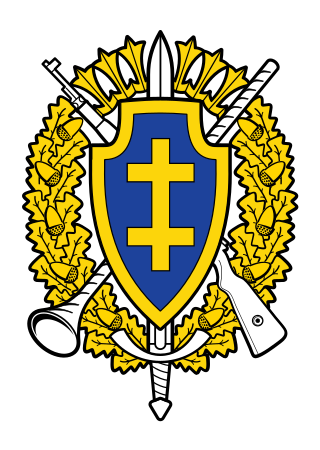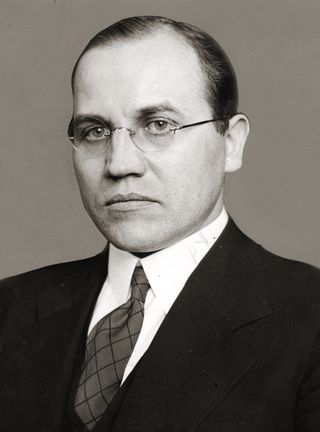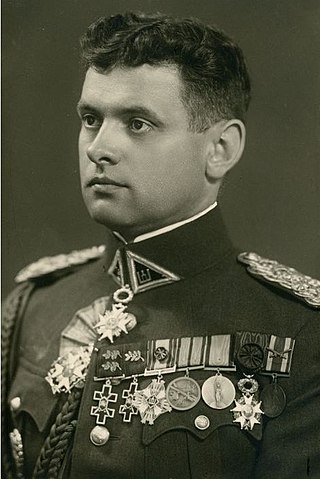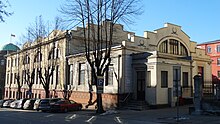
The Lithuanian Riflemen's Union, also referred to as Šauliai, is a paramilitary non-profit organization supported by the Government of Lithuania. Their activities are in three main areas: military training, sport, and culture, but vary between peace and war time.
Lietuvos žinios was a daily newspaper in Lithuania. Established in Vilnius in 1909, it was a liberal newspaper representing the Lithuanian Democratic Party. Even though its publication was interrupted by World War I and Soviet occupation of Lithuania, Lietuvos žinios billed itself as the oldest newspaper in Lithuania.

Juozas Lukša, also known among other pseudonyms as Daumantas and Skirmantas, was a leader of the anti-Soviet Lithuanian partisan armed resistance movement.

Lietuvos aidas is a daily newspaper in Lithuania. It was established on September 6, 1917, by Antanas Smetona, and became the semi-official voice of the newly formed Lithuanian government. When the government evacuated from Vilnius to the temporary capital, Kaunas, it ceased publication. The newspaper was revived in 1928 as the newspaper of the Lithuanian government and became the most popular newspaper in Lithuania. At its peak, it published three daily editions with combined circulation of 90,000 copies. World War II disrupted its publication. In 1990, after Lithuania declared independence from the Soviet Union, the newspaper once again became the official newspaper of the Supreme Council of the Republic of Lithuania. At the end of 1992, its circulation reached 103,000 copies. However, it was soon privatized and faced shrinking readership, financial difficulties, and other controversies. In April 2006, bankruptcy proceedings were initiated by the State Tax Inspectorate when its tax debts reached more than 4 million litas. The company was liquidated in 2015, but the newspaper continues to be published by a non-profit organization.
Before the independence from the Soviet Union (USSR) in 1990, Lithuanian print media sector served mainly as a propaganda instrument of the Communist Party of Lithuania (LKP). Alternative and uncontrolled press began to appear in the country starting from 1988, when the Initiative Group of the Reform Movement of Lithuania Sąjūdis was established. After the declaration of independence the government stopped interfering in the media outlets which for the most part were first privatised to their journalists and employees and later to local businessman and companies. Currently media ownership in Lithuania is concentrated among a small number of domestic and foreign companies.

Kazys Škirpa was a Lithuanian military officer and diplomat. He is best known as the founder of the Lithuanian Activist Front (LAF) and his involvement in the attempt to establish Lithuanian independence in June 1941.

The Soviet–Lithuanian Mutual Assistance Treaty was a bilateral treaty signed between the Soviet Union and Lithuania on October 10, 1939. According to provisions outlined in the treaty, Lithuania would acquire about one fifth of the Vilnius Region, including Lithuania's historical capital, Vilnius, and in exchange would allow five Soviet military bases with 20,000 troops to be established across Lithuania. In essence the treaty with Lithuania was very similar to the treaties that the Soviet Union signed with Estonia on September 28, and with Latvia on October 5. According to official Soviet sources, the Soviet military was strengthening the defenses of a weak nation against possible attacks by Nazi Germany. The treaty provided that Lithuania's sovereignty would not be affected. However, in reality the treaty opened the door for the first Soviet occupation of Lithuania and was described by The New York Times as "virtual sacrifice of independence."

The Lithuanian partisans were partisans who waged a guerrilla warfare in Lithuania against the Soviet Union in 1944–1953. Similar anti-Soviet resistance groups, also known as Forest Brothers and cursed soldiers, fought against Soviet rule in Estonia, Latvia and Poland. It is estimated that a total of 30,000 Lithuanian partisans and their supporters were killed. The Lithuanian partisan war lasted almost for a decade, thus being one of the longest partisan wars in Europe.

The Supreme Committee for the Liberation of Lithuania or VLIK was an organization seeking independence of Lithuania. It was established on November 25, 1943, during the Nazi occupation. After World War II it moved abroad and continued its operations in Germany and the United States. VLIK claimed to be the legal representative of the Lithuanian parliament and government, but it did not enjoy international recognition. It was dissolved in 1990, when Lithuania re-established its independence.
The Diplomatic Service of the Republic of Lithuania is the part of the governmental service tasked with enforcing the foreign policy set by the President, the Parliament, and the Government of the Republic of Lithuania. The head of the service is the Foreign Minister.

Jeronimas Plečkaitis was a Lithuanian politician. He was a member the national parliament, the Seimas, from 1920 to 1927, representing the Social Democratic Party of Lithuania. After the military coup d'état of December 1926, Plečkaitis became an active member of the opposition to President Antanas Smetona and Prime Minister Augustinas Voldemaras. He participated in the failed Tauragė Revolt in September 1927 and fled abroad to avoid arrest. He organized a group of men, known as plečkaitininkai, that received assistance from Poland and continued to plot against the Lithuanian government. He was arrested by the German police in September 1929 and sentenced to three years in prison. He was arrested again by Lithuania in 1940. In 1944, he was arrested by the Soviet authorities and sent to a Gulag camp in the Tyumen Oblast. He returned to Lithuania in 1955.
Vairas was a Lithuanian-language political and cultural newspaper published by Antanas Smetona and the Lithuanian Nationalist Union, the ruling party in Lithuania in 1926–1940. It was published three separate times. Vairas was first established in January 1914 when Smetona departed Viltis; it was discontinued due to World War I. The newspaper was briefly revived in September 1923 when Smetona and Augustinas Voldemaras harshly criticized their political opponents and the Lithuanian government. Due to anti-government rhetoric, their newspapers were closed by state censors one after another, but they would quickly establish a new newspaper under a new title. Vairas was closed in February 1924. The newspaper was reestablished as a cultural magazine in 1929 with the backing of the authoritarian regime of Smetona. In 1939, it became a weekly political magazine that pushed an agenda of radical nationalism and openly sympathized with National Socialism. The magazine was discontinued after the Soviet occupation of Lithuania in June 1940.

Vaclovas Sidzikauskas was a prominent diplomat in interwar Lithuania and post-war anti-communist.
Edvardas Turauskas was a Lithuanian diplomat.

Pavasarininkai was the informal name for members of Pavasaris, a Lithuanian Catholic youth organization. It was active from 1912 to the Soviet occupation in 1940. It grew from various informal groups established around the Pavasaris magazine first published in May 1912. It was based in Kaunas, but most members were active in various rural location across Lithuania. With more than 90,000 members and 1,200 groups in 1940, it was one of the largest and most popular organizations in interwar Lithuania. Its motto was "For God and Fatherland" and it organized various events to educate the youth in the Catholic spirit and develop their national pride. Pavasarininkai were supported by local clergy and the Catholic hierarchy, but were frowned upon by the authoritarian regime of President Antanas Smetona. It was similar to and closely cooperated with the Catholic Youth Federation Ateitis.

Gitanas Nausėda is a Lithuanian politician, economist and banker who is serving as the ninth and current president of Lithuania since 2019. He was previously director of monetary policy at the Bank of Lithuania from 1996 to 2000 and chief economist to the chairman of SEB bankas from 2008 to 2018.

Konstantinas Dulksnys was a Lithuanian colonel of the General Staff, intelligence officer, lecturer.

The Leninist Young Communist League of Lithuania or Lithuanian Komsomol was the Lithuanian branch of the Soviet Komsomol that served as the youth organ of the Communist Party of Lithuania. The organization was for youth ages 14 to 28. Younger children were organized into Pioneers and Little Octobrists. Since Komsomol was the only legal youth organization in the Soviet Union, it had significant impact and influence on the youth.
Vilnius Vytautas Magnus Gymnasium is a gymnasium in Vilnius, Lithuania. Established in 1915, it became the first Lithuanian-language high school in the city. During the interwar period, the school was one of the key Lithuanian institutions in Vilnius Region which was incorporated into the Second Polish Republic and claimed by Lithuania. Many prominent Lithuanians worked and studied at the school.














